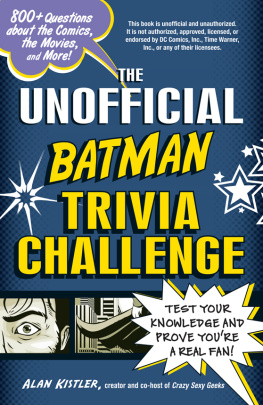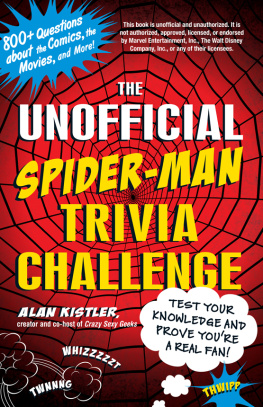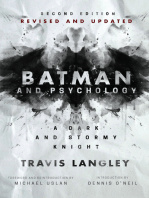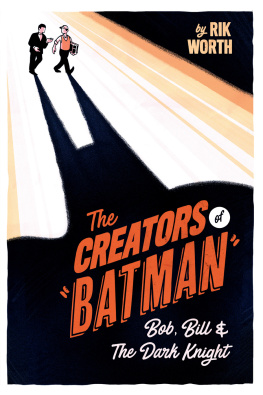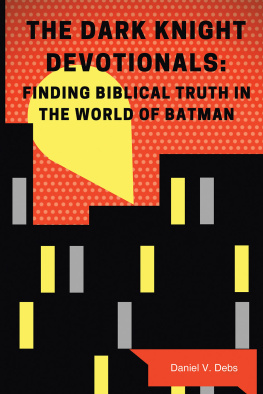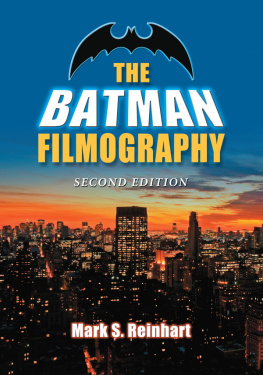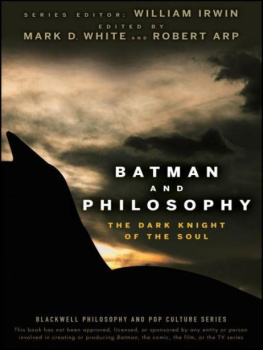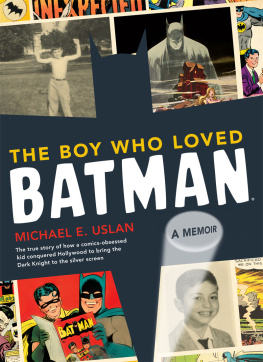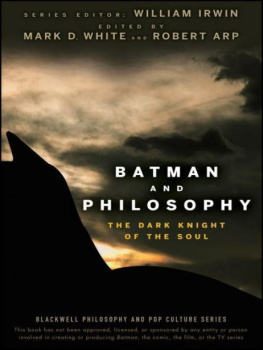When dealing with a character whose adventures have been in continuous publication for over seven decades, it is impossible to put together a book like this without help along the way. Lisa McMullan was a constant support and reminded me to take necessary breaks before my mind became overwhelmed with jotting down Batman facts. Thanks to Robert Greenberger, a veteran of Marvel and DC Comics, as well as the author of The Essential Batman Encyclopedia. Kiri Callaghan was very helpful in the late hours of the night, making sure my sidebars and questions were clear. Jennifer Ewing effectively played both a support role and that of taskmaster, making sure my mind didnt wander too much in the midst of my work.
Brandi Bowles is a fine agent and effectively helped bring this project into being. Over at Adams Media, Victoria Sandbrook was a joy to work with again, and she and Peter Archer were very patient and open in their communications with me as we put this all together.
Finally, thanks to all the writers, artists, directors, producers, and storytellers who have each given life to some aspect of the Batman, creating a modern-day mythology that will outlast us all.
Introduction
P eople the world over may recognize Batman, even by the shape of his shadow, and yet argue over who he is. It depends on how youve entered the world of the Dark Knight and how much exposure youve had to the rest of his strange multiverse.
If you began with the 1989 film Batman, directed by Tim Burton, you may think of Bruce Wayne as a strange, slightly awkward businessman who then becomes a dark vigilante at night, repeatedly placing his enemies in situations where theyre sure to die. If you began with the live-action TV show from the 1960s that starred Adam West and Burt Ward as the dynamic duo, your first impression of Batman is not the Dark Knight but a Caped Crusader, wearing a blue and gray outfit as he openly worked as a recognized law enforcement official, chasing down criminals in broad daylight. The villains committed strange crimes but, more often than not, didnt seem interested in threatening innocent lives. A similar Batman appears in the recent cartoon series Batman: The Brave and the Bold, one who takes himself more seriously than the Adam West incarnation and deals with more dangerous threats, yet still engages in puns, heavy alliteration, and refers to his fists as the hammers of justice.
And then there is the version that has stalked the comic book pages for decades, captured in film adaptations directed by Chris Nolan, and in various cartoon adventures, beginning with Batman: The AnimatedSeries in the 1990s. This Batman is a dark creature of the night, but not lethal like Burtons vision. All life is precious to him, and while he fights monsters, he refuses to live by their rules or adopt their morality. Justice is not supposed to be easy and principles cannot be abandoned when they are inconvenient. Like the other incarnations, he has no superhuman abilitiesbut try telling that to some of the criminals he faces. All they see is a dark winged creature with long ears that resemble devil horns, one whose eyes are blank, reflective mirrors, a being who leaps from the shadows, shrugs off gunfire, can fire blades from his hands, and then vanishes again before you even have a chance to lay a hand on him. He is truly a Dark Knight of Gotham City, traveling the world in his pursuit of criminals and evil.
Wayne is attending the theater (or, in one version, the opera) with his parents, Thomas and Martha. Both adults come from wealthy families, and both have spoken to their son of the importance of helping others less fortunate. They leave the theater and walk through an alleyway. (Depending on your version of the story, they do this out of convenience or because its a short cut to a clinic run by a dear friend of Thomass.) A mugger named Joe Chill lies in wait. He wants Marthas pearls and when he grows impatient and reaches for them, Thomas Wayne tries to protect his wife. Panicked, the mugger fires his first shot into Thomas, followed by another as he silences Marthas screams. As Joe Chill runs from the scene of his crime (often leaving his gun behind in the comic book stories), Bruce Wayne is left alone, kneeling in his parents blood; his universe has just been destroyed.
In most versions of the origin, Bruce has survivors guiltthe boy believes he could have done something to save his parents. In some comics, Bruce asked his mother to wear her pearl necklace that night to make the evening special as he rarely had a chance to spend time with both parents. He recalls this fact with shame after the murder, realizing the first thing the mugger asked for was the necklace. In the film Batman Begins, Bruce blames himself because the young boy was frightened by the show, which led to the Waynes leaving through the side door, directly into the path of a mugger. Whatever the case, a child (between eight and ten years old) believes this murder is his fault.
Bruce Wayne had every reason to become a villain. He could have allowed his guilt to corrupt him, choosing a path of self-destruction. He could have decided that his parents were wrong, that the lower classes are not worth helping if one is willing to kill two people who tried to help them. He could have concluded that the world is a bleak place without order and the only sane response is to embrace it. Instead, he chose a different path. No one else would suffer as he had. No one else would know this painnot if he could help it.
No matter the incarnation, the story begins the same way. After years of traveling the world, gaining what knowledge he needed, training his body and mind to their peak, Bruce Wayne was ready to start his crusade in earnest. And now comes the totem.
Starting from the first revelation of his origin, comic book readers saw Bruce Wayne in his study, wondering what was still missing from his arsenal. He wanted criminals to fear him as a supernatural force rather than a mortal man, believing it was the necessary edge required to survive and quickly build a reputation. As he remarks that he must play on the fears of criminals, noting that they are a superstitious, cowardly lot, the universe responds: a bat flies in through the window, an omen. In the 1986 retelling of the origin story, Batman: Year One, Bruce is suffering blood loss from a gunshot wound when this happens, and just as he rings a bell to summon Alfreds aid, a moment before he loses consciousness, he whispers, Yes, father I shall become a bat.

